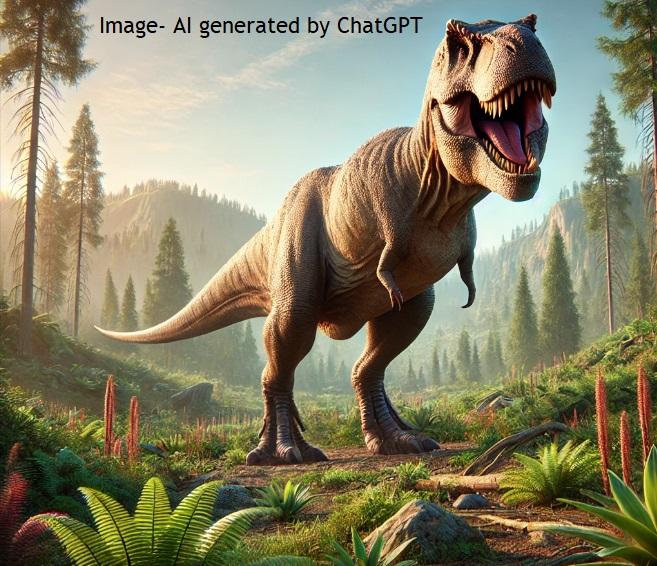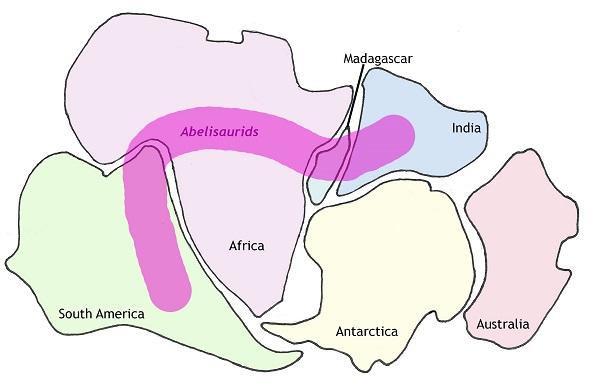
Changing the way we look at the world
In this blog I want to continue writing about dinosaur biogeography and focus on a few species of Theropod dinosaurs. Theropod dinosaurs walked on their hind legs, had small “arms” and became large meat eaters. The best known theropod dinosaur is probably Tyrannosaurus rex. It was one of the largest theropods.

Fossils of this fearsome creature are found in Upper Cretaceous rocks of North America with other similar creatures which belong to the family Tyrannosauridae [AKA Tyrannosaurids]. T rex has only been found in North America, but other similar creatures have been found in Mongolia. These were relatively late comers as far as dinosaurs were concerned. There were many other theropods before T rex came on the scene.
One example is Ceratosaurus which was found in Jurassic rocks of North America, South America and Europe. Allosaurus was also found in Jurassic rocks. One of the best-known specimens of Allosaurus, “Big Al", is a 95% complete, partially articulated skeleton found in Wyoming, USA in 1991. Allosaurus fossils have also been found in North America and Europe. Carcharodontosaurus was similar although it had teeth which resembled shark’s teeth hence its name [shark-toothed lizard]. It was found in North African Mid Cretaceous rocks. Allosaurus and Carcharodontosaurus belong to the Allosauroidea [AKA Allosauroid] super family.
Theropod fossils have also been found in South America, for example, Abelisaurus and Carnotaurus. Abelisaurus [only the skull] was found in Argentina. An almost complete skeleton of Carnotaurus which was similar was also found in Argentina. Carnotaurus had short ‘horns’ and very short arms. These and other similar creatures found in Upper Cretaceous rocks are members of the Abelisauridae [AKA Abelisaurid] family.
Apart from the animals named above, many species of theropod dinosaurs are known from rather fragmentary fossils and the allocation to families can sometimes change as more specimens are discovered.
It is interesting to see where the various species were found.
A number of species of Abelisaurids were found in Cretaceous rocks of South America. Others have been found in Africa, Madagascar and India. These places are now separated by thousands of miles of ocean. The question is, how did these species, which seem to be related to each other, get to be living on three different continents?
If we look at a map of Pangaea, we see that these continents were once together as part of Gondwana (southern Pangaea). Pangaea was a supercontinent which existed at the time Permian rocks were being deposited. It started to break up as Jurassic rocks were laid down and dinosaurs were becoming more common.

It seems likely that the various species of Abelisaurids descended from a common ancestor and would have spread out across Gondwana before it started to split up. As Gondwana broke up the rising and falling sea levels, caused by seafloor spreading, resulted in regional flooding and the deposition of the rocks in which these fossils were found.
There is morphological evidence that members of this family descended from a few common ancestors found in Triassic and Jurassic rocks. The greatest variety of species are found in Cretaceous rocks all over the world.
This evidence can be used to develop a post-flood diversification model of dinosaur biogeography. The starting point would be that all theropods and other dinosaurs descended from a few dozen kinds which repopulated the earth after the end of the flood of Noah. The earliest post-flood dinosaurs would have left the ark no later than the time the Triassic rocks were laid down on the newly exposed earth of the super-continent of Pangaea.
As they occupied new lands the few species coming off the ark, would have multiplied and diversified into the species which we find as fossils in Jurassic and Cretaceous rocks.

Fossils of this fearsome creature are found in Upper Cretaceous rocks of North America with other similar creatures which belong to the family Tyrannosauridae [AKA Tyrannosaurids]. T rex has only been found in North America, but other similar creatures have been found in Mongolia. These were relatively late comers as far as dinosaurs were concerned. There were many other theropods before T rex came on the scene.
One example is Ceratosaurus which was found in Jurassic rocks of North America, South America and Europe. Allosaurus was also found in Jurassic rocks. One of the best-known specimens of Allosaurus, “Big Al", is a 95% complete, partially articulated skeleton found in Wyoming, USA in 1991. Allosaurus fossils have also been found in North America and Europe. Carcharodontosaurus was similar although it had teeth which resembled shark’s teeth hence its name [shark-toothed lizard]. It was found in North African Mid Cretaceous rocks. Allosaurus and Carcharodontosaurus belong to the Allosauroidea [AKA Allosauroid] super family.
Theropod fossils have also been found in South America, for example, Abelisaurus and Carnotaurus. Abelisaurus [only the skull] was found in Argentina. An almost complete skeleton of Carnotaurus which was similar was also found in Argentina. Carnotaurus had short ‘horns’ and very short arms. These and other similar creatures found in Upper Cretaceous rocks are members of the Abelisauridae [AKA Abelisaurid] family.
Apart from the animals named above, many species of theropod dinosaurs are known from rather fragmentary fossils and the allocation to families can sometimes change as more specimens are discovered.
It is interesting to see where the various species were found.
A number of species of Abelisaurids were found in Cretaceous rocks of South America. Others have been found in Africa, Madagascar and India. These places are now separated by thousands of miles of ocean. The question is, how did these species, which seem to be related to each other, get to be living on three different continents?
If we look at a map of Pangaea, we see that these continents were once together as part of Gondwana (southern Pangaea). Pangaea was a supercontinent which existed at the time Permian rocks were being deposited. It started to break up as Jurassic rocks were laid down and dinosaurs were becoming more common.

It seems likely that the various species of Abelisaurids descended from a common ancestor and would have spread out across Gondwana before it started to split up. As Gondwana broke up the rising and falling sea levels, caused by seafloor spreading, resulted in regional flooding and the deposition of the rocks in which these fossils were found.
There is morphological evidence that members of this family descended from a few common ancestors found in Triassic and Jurassic rocks. The greatest variety of species are found in Cretaceous rocks all over the world.
This evidence can be used to develop a post-flood diversification model of dinosaur biogeography. The starting point would be that all theropods and other dinosaurs descended from a few dozen kinds which repopulated the earth after the end of the flood of Noah. The earliest post-flood dinosaurs would have left the ark no later than the time the Triassic rocks were laid down on the newly exposed earth of the super-continent of Pangaea.
As they occupied new lands the few species coming off the ark, would have multiplied and diversified into the species which we find as fossils in Jurassic and Cretaceous rocks.
